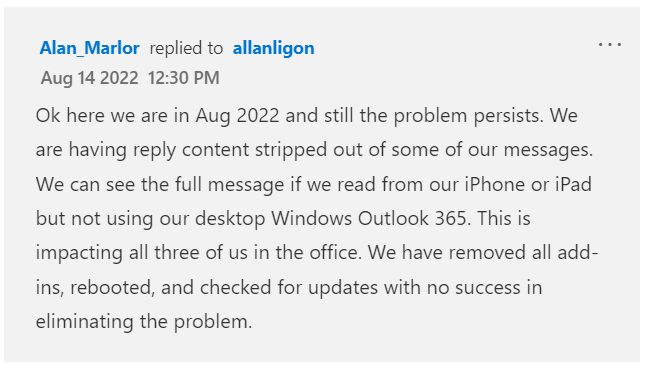Outlook not Displaying Email Content? Here's How to Fix it
6 min. read
Updated on
Read our disclosure page to find out how can you help MSPoweruser sustain the editorial team Read more

Outlook can sometimes be problematic, and one of the situations you wouldn’t want to experience while using it is not being able to view the body or the texts of your emails.
This issue could be caused by a variety of reasons, which also means different solutions to explore.
https://twitter.com/MSFT365Status/status/1392208966231355392
In May 2021, this became a widespread issue across Outlook users using the app’s desktop version globally. The root cause of the problem originated from a faulty update (Outlook version 2104 build 13929.20372) that introduced a bug to the desktop client that later caused users to be unable to view or compose (as pressing enter would hide the texts) emails.
According to Microsoft, “a recent change to systems that facilitate text display management for content within the Outlook client” started it but immediately addressed it hours after tons of reports.
Experiencing the same situation today is possible, especially if you hear complaints from others around the globe. In that case, it’s probably a bug on Microsoft’s end. If it happens after an update, just like the situation stated above, rolling back to the previous
Microsoft Outlook version using the command prompt can do the trick. Before doing so, however, it is important first to check if it is really being experienced by many users due to a bug. If not, it is probably caused by a different issue, thus rolling back to the previous version of Outlook will be pointless.

After that incident in 2021, there are still reports from different Outlook users experiencing the same problem. If you were one of those who experienced that last year and are now experiencing it again, you should now try a different kind of solution.
The first basic Outlook troubleshooting you should do is check if the problem is occurring just on Outlook for PC or even on the iOS, Android, or web version of Outlook.
If you can see the texts on other platforms, you can use them as a workaround to keep your productivity going, and it will also allow you to identify which platforms are just facing such an issue. And if it is happening on the desktop version of Outlook, you can start with a simple relaunch, although some users are encountering an issue where Outlook won’t open.
You can also try ending any Outlook-related tasks on the Tasks Manager. Also, try to check if the font color of the plain text on Outlook is not set to white.
In the Outlook app, go to File > Options menu > Mail tab > Stationery and Fonts > Personal Stationery tab. Find the “Composing and reading plain text messages” and select the Font button under it. In the dialog box that will open, check if the font is set in Automatic, which should give you the black font color.
If these simple solutions don’t work, here are more advanced suggestions.
Disable or remove add-ins
Ad-ins can sometimes affect the performance of Outlook, so it is a good idea to disable them to see if they are really the cause of the problem. One of the most prominent ad-ins that could cause it is the Avgoutlook.Addin as well as other antivirus ad-ins. To disable or remove them, open the Outlook application and go to the File menu > Options > Add-ins tab. In the tab, click the Go button at the bottom, and you’ll see all the available ad-ins with checkmarks. Uncheck the ones related to Outlook and click the OK button to disable them. To completely remove them, uncheck the ones you want to keep and check the ones you need to remove. Restart your PC.
Repair corrupted Outlook .pst files
Microsoft has the Inbox Repair tool (Scanpst.exe) that you can use to repair your Outlook personal folder files when you can’t access them. Start it and select Open or Run in the File Download dialog box. If you can’t find it, Microsoft provides a list of locations where you can find it depending on your Outlook version. Once launched, type the path and the file name of your .pst file in the Inbox Repair tool. You can also select Browse to locate the file using the Windows file system.
To see the paths of data folders, open Outlook and go to File > Account Information > Account Settings > Data files tab. Put the path to the Inbox Repair tool. Click on the Repair button to start the repairing process. Also, Stellar Information Technology Pvt. Ltd. offers Stellar PST File Recovery Tool, which scans and recovers corrupted PST files in the fastest way possible. Due to the tool’s advanced scanning algorithms, it shows output results only targetting the selective data by omitting unnecessary data scans.
However, note that you might need to run Inbox Repair Tool several times to fully repair a .pst file. Also, the tool might not always work for all problems, especially for those files permanently deleted or corrupted beyond repair. After repairing, proceed to recover repaired items. To do that, you first need to create a new Personal Folders (.pst) file entry in your profile so you can move the recovered items. Start Outlook, select the profile containing the repaired .pst file, press Ctrl+6 to turn on the Folder List view, and create a new .pst file in your profile.
The process depends on the version of Outlook you are using, but Microsoft has a detailed document for it, from Outlook 2002 to Outlook 2010 and later. After that, drag the recovered items from the Lost and Found folder (which contains folders and items that the Inbox Repair Tool recovered) to your new Personal Folders (.pst) file.
Restart Outlook in Safe Mode
Another way to use your Outlook with all the ad-ins disabled is through Safe Mode. It can also be a good alternative in cases where you don’t want to roll back to a previous version of Microsoft Office to fix some bugs while waiting for Microsoft to resolve the issue. To do this, press and hold the Ctrl key and launch Outlook. Confirm by clicking Yes in the dialog box that will appear. The Outlook will then open in Safe Mode. Once you are done using it, you can simply close it, but you need to open the app in this way to keep it under Safe Mode. Another simple way to open Outlook in Safe Mode is by simultaneously pressing Windows and R hotkeys and typing outlook.exe/safe.
Update Outlook
One of the best things to do is to update your Outlook app to see if there are essential updates that could fix the problem. Just go to File > Office Account > Update Options >Update Now button. This is applicable, especially if an earlier update is faulty and Microsoft is releasing a new one to resolve it. On the other hand, you probably also want not to get automatic updates to prevent the installation of such buggy updates. In that case, disable Microsoft Office updates. Open your Outlook and go to File menu > Office Account > Update options > select Disable Updates. Click the Yes button on the prompt that will appear to confirm the action.









User forum
6 messages